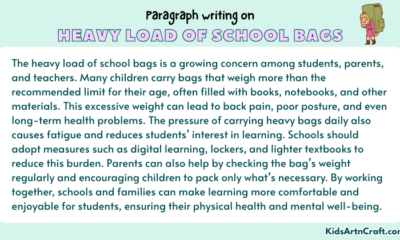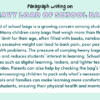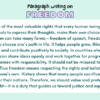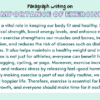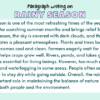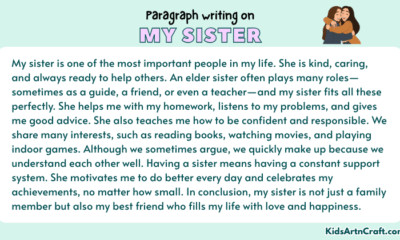Paragraph Writing
Paragraph on Recycling
Let’s practice paragraph writing on the topic “Recycling” through Expository, Persuasive, Descriptive, and Narrative styles, using clear writing structures like PEEL, TEEL, TEXAS, and the Hamburger Model for better flow.
Most of our paragraphs are in 150 to 200 words. You can also find longer paragraphs (in 300 words) on ‘Recycling’ or essays on the same topic on the web.
Different Styles of Paragraphs on ‘Recycling’
1. Expository Paragraph on Recycling (Explains with Facts)

Recycling is the process of converting waste materials into new products to reduce environmental pollution and conserve natural resources. It involves collecting materials such as paper, plastic, glass, and metal, which are then cleaned, processed, and remade into usable items. For instance, recycled paper can be turned into notebooks, while plastics can become containers or furniture. Recycling helps conserve energy because producing items from recycled materials requires less energy than making them from raw resources. Additionally, it reduces the amount of waste sent to landfills, which can cause soil and water pollution. Cities and communities often provide recycling bins and organize campaigns to educate people about separating waste properly. Recycling also plays a vital role in protecting wildlife, as it prevents harmful materials from contaminating natural habitats. With growing awareness, individuals, schools, and businesses are increasingly participating in recycling programs. Overall, recycling is a practical solution to the global problem of waste management and environmental degradation, making it an essential practice for a sustainable future.
2. Persuasive Paragraph on Recycling (Tries to Convince You)
Recycling is not just a choice; it is a responsibility that everyone should embrace to protect our planet. By recycling everyday items like paper, plastic, and metal, we can significantly reduce the harmful waste that pollutes our land, water, and air. Imagine the positive impact if every household separated their waste properly—landfills would shrink, energy consumption would decrease, and natural resources would be preserved. Recycling also reduces the need for cutting down trees and extracting minerals, which can destroy ecosystems. Schools and communities should make recycling a habit by providing bins and conducting awareness campaigns. Even small actions, like reusing plastic bottles or composting organic waste, contribute to a cleaner and healthier environment. Every recycled item is a step toward fighting climate change and protecting wildlife. Therefore, we must act now and encourage others to recycle, because the future of our planet depends on the choices we make today. Recycling is not just helpful; it is essential.
3. Descriptive Paragraph on Recycling (Paints a Picture with Words)
Recycling transforms waste into a world of color, texture, and purpose. Picture mountains of discarded plastic bottles, metal cans, and torn newspapers stacked in bins, waiting to be reborn. The process begins as workers sort and clean each item, separating glass that glistens under bright lights, crumpled paper that rustles with every movement, and shiny metal that clangs as it collides. As machines crush, melt, and reshape these materials, the once-useless waste becomes new objects: notebooks, jars, toys, and furniture. The air smells faintly of paper pulp and plastic, mixed with the earthy scent of composted organic matter. Bins painted green, blue, and yellow line streets, silently inviting people to participate. Each recycled item tells a story of transformation and care for the environment. The sight of a clean park or a thriving forest reminds us why recycling matters. The movement of materials from trash to treasure creates a rhythm of renewal, showing how human effort and natural resources can coexist in harmony.
4. Narrative Paragraph on Recycling (Tells a Story)
Last week, I decided to take recycling more seriously after seeing how much waste my family produced. I began by separating paper, plastics, and metals into different bins in our home. On Saturday, I visited the local recycling center, where I watched mountains of bottles, cans, and newspapers being sorted by workers. I was amazed to see machines crushing and melting plastics and metals, while paper was pulped and pressed into new sheets. A staff member explained that each item I recycled could be turned into something useful, like a notebook, jar, or chair. Feeling inspired, I returned home and convinced my neighbors to start recycling too. Over the next few days, our street became cleaner, and fewer trash bags went to the landfill. I realized that small actions, like separating waste, could make a big difference. Recycling had become more than a habit—it was a way to care for the environment and create a better future for everyone. That experience taught me that change starts with a single action.
‘Recycling’ Paragraphs in Different Structured Methods
1. Recycling Paragraph Writing with PEEL Method
PEEL Method (Point, Evidence, Explanation, Link)
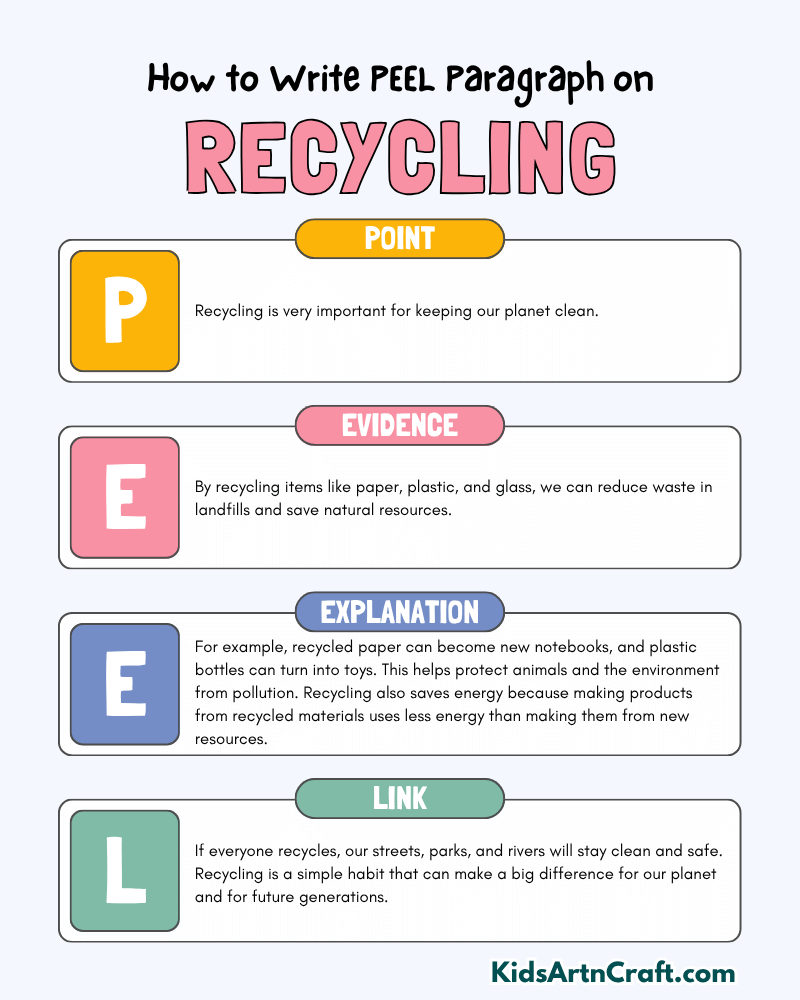
Point: Recycling is very important for keeping our planet clean.
Evidence: By recycling items like paper, plastic, and glass, we can reduce waste in landfills and save natural resources.
Explanation: For example, recycled paper can become new notebooks, and plastic bottles can turn into toys. This helps protect animals and the environment from pollution. Recycling also saves energy because making products from recycled materials uses less energy than making them from new resources.
Link: If everyone recycles, our streets, parks, and rivers will stay clean and safe. Recycling is a simple habit that can make a big difference for our planet and for future generations.
2. Recycling Paragraph Writing with TEEL Method
TEEL Method (Topic, Evidence, Explanation, Link)
Topic Sentence: Recycling is a good way to help the Earth.
Evidence: For instance, glass bottles and metal cans can be melted and made into new items. Paper can be recycled into notebooks or books. Recycling also saves trees and energy.
Explanation: It reduces garbage and prevents pollution.
Link: When we recycle at home or school, we help protect animals, keep our surroundings clean, and make the planet a better place.
3. Recycling Paragraph Writing with the TEXAS Method
TEXAS Method (Topic, Example, Explanation, Analysis, Summary/Significance)
Topic: Recycling is very helpful for the environment.
Example: Plastic bottles can be made into chairs, and old newspapers can become new paper.
Explanation: It changes waste into useful things and reduces pollution.
Analysis: This process saves energy, conserves natural resources, and protects wildlife from harmful trash.
Summary: Everyone should recycle daily, because even small actions can make a big difference in keeping our Earth clean and safe.
4. Recycling Paragraph Writing with Hamburger Method
Hamburger Method (Top Bun, The Fillings, Bottom Bun)
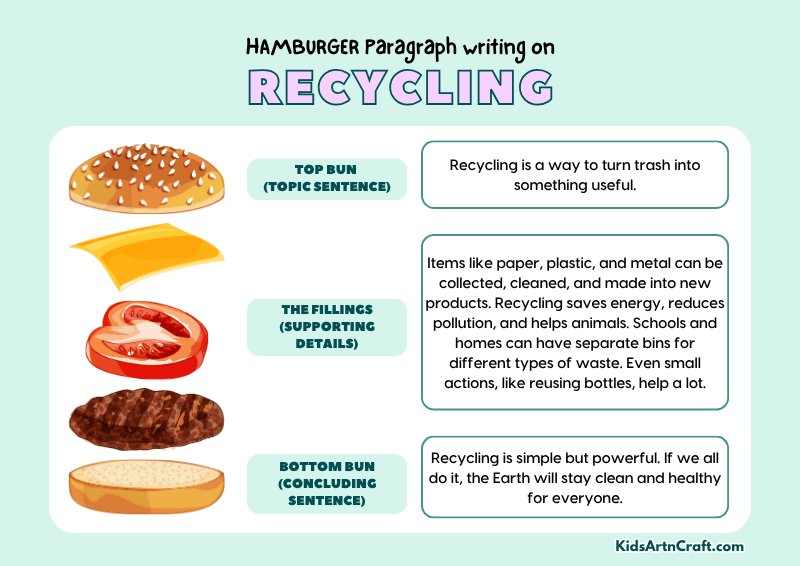
Top Bun (Topic Sentence):
Recycling is a way to turn trash into something useful.
The Fillings (Supporting Details):
Items like paper, plastic, and metal can be collected, cleaned, and made into new products. Recycling saves energy, reduces pollution, and helps animals. Schools and homes can have separate bins for different types of waste. Even small actions, like reusing bottles, help a lot.
Bottom Bun (Concluding Sentence):
Recycling is simple but powerful. If we all do it, the Earth will stay clean and healthy for everyone.
Hope you liked these paragraphs on ‘Recycling ’. Don’t forget to join the Telegram group for FREE Printables.
Check this article to create recycled bottle crafts with seeds.



